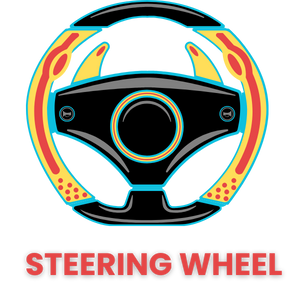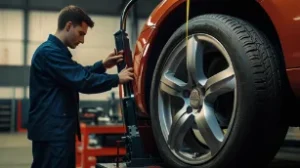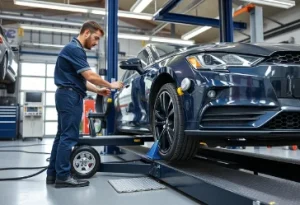Why Wheel Alignment and Steering Alignment Matter More Than You Think
Have you noticed your car pulling to one side or uneven tire wear? These might seem minor, but they’re likely signs of misalignment—a serious issue that impacts your vehicle’s performance. Poor alignment doesn’t just shorten tire life; it forces your engine to work harder, increasing fuel consumption and leading to costly repairs.
Proper wheel and steering alignment are essential for safety and performance. Misalignment can cause your car to drift, making it difficult to control, especially at high speeds. By keeping everything aligned, you extend tire life, save on fuel, and ensure a safer, smoother drive.
This blog will take you through everything you need to know about wheel alignment and steering alignment, helping you avoid these pitfalls and keep your vehicle in top shape. From understanding the basics to identifying symptoms and learning preventative maintenance, this guide is your comprehensive resource for maintaining optimal alignment.
1) Understanding Wheel Alignment and Steering Alignment
What is Wheel Alignment?
Wheel alignment involves adjusting a vehicle’s suspension—the system that connects the vehicle to its wheels. This process doesn’t involve the tires or wheels themselves but ensures that the wheels point in the correct direction relative to the road and each other, maximizing tire life, performance, and safety. The three key angles involved in wheel alignment are toe, camber, and caster:
- Toe Alignment: This angle determines whether the tires turn inward or outward when viewed from above. Incorrect toe alignment leads to faster tire wear, especially on the edges.
- Camber Alignment: This is the inward or outward tilt of the tire when viewed from the front. Too much tilt causes uneven tire wear and affects cornering stability.
- Caster Alignment: This angle impacts the steering axis when viewed from the side. Positive caster enhances stability at high speeds, while incorrect caster can cause the vehicle to pull to one side or make the steering feel imbalanced.
What is Steering Alignment?
Steering alignment, often confused with wheel alignment, refers specifically to ensuring the steering wheel is centered, allowing the car to drive straight without pulling to one side. Misalignment in steering can cause the vehicle to veer in one direction, making driving frustrating and unsafe.
Accurate Steering Response with Proper Alignment

- Improved Steering Response: Proper alignment ensures your vehicle responds accurately to steering inputs.
- Unpredictable Behavior with Misalignment: Even slight misalignment can lead to unpredictable behavior, especially at high speeds or during emergencies.
- Safety Compromises: Misalignment increases safety risks by requiring constant steering corrections.
- Increased Driver Fatigue: Continuous adjustments make driving more tiring and stressful.
2) Benefits of Proper Wheel and Steering Alignment

- Better Vehicle Handling: Proper alignment improves overall handling and control.
- Predictable Steering Inputs: An aligned vehicle responds consistently to steering, enhancing safety.
- Maintains Straight Path: Proper alignment ensures the vehicle stays on a straight path without constant adjustments.
- Enhanced Driving Comfort: Correct alignment reduces driver fatigue and improves comfort, especially on long drives.
3) Understanding Alignment Terms and Their Impact
The Impact of Incorrect Toe Alignment
- Rapid Tire Wear: Incorrect toe alignment causes tires to scrub against the road, leading to rapid, uneven wear.
- Increased Fuel Consumption: The scrubbing effect forces the vehicle to work harder, increasing fuel consumption.
Prevent Premature Wear with Regular Checks
- Maintain Tire Health: Regularly checking and adjusting toe alignment prevents premature tire wear.
- Boost Fuel Efficiency: Proper toe alignment reduces unnecessary friction, helping maintain optimal fuel efficiency.
Understanding Alignment Terms
- Know the Angles: Understanding terms like toe, camber, and caster is essential for maintaining your vehicle. If you have a loose steering wheel, these alignment angles may be off, causing poor handling and safety concerns.
- Communicate Effectively: Familiarity with these terms helps you communicate better with your mechanic and make informed maintenance decisions.
- Ensure Regular Checks: Regular alignment checks are crucial for your vehicle’s overall health, helping prevent issues before they cause significant damage.
| More to Explore for Your Interest: You Will Also Enjoy Reading | |
| 1 | Steering Wheel Repair: New 6 Ultimate Fixes for Hidden Issue |
| 2 | How to unlock steering wheel without key: 5 Proven Ways |
| 3 | Why Is My Steering Wheel Hard to Turn? Reasons & Easy Fixes |
4) Causes of Wheel and Steering Alignment Issues
- Everyday Driving Hazards: Misalignment can occur from everyday driving activities such as hitting potholes, clipping curbs, or driving over speed bumps too quickly. Poor road conditions, like uneven surfaces, can exacerbate these issues.
- Worn Suspension Parts: Worn suspension components, like ball joints and control arms, can cause your vehicle to pull to one side or wear tires unevenly. Regular maintenance of the suspension system is crucial as it supports the vehicle’s weight and absorbs road shocks, keeping the wheels properly aligned.
- Unsafe Driving Habits: Aggressive driving, like speeding through corners or hard braking, can stress the suspension and lead to misalignment. Overloading or unevenly distributing weight in your vehicle can also cause alignment issues. Adopting safe driving habits helps maintain alignment and extends the life of your tires.
- Irregular Inspections: Regularly inspect your suspension components and replace any worn or damaged parts to prevent misalignment. Keeping your suspension in good condition ensures your wheels stay properly aligned, enhancing your vehicle’s performance and tire longevity.
5) Diagnosis of Wheel and Steering Alignment Problems
Spotting Misalignment: Key Warning Signs
- Uneven Tire Wear: is a common indicator of misalignment; if one side of a tire is more worn, your alignment needs attention.
- Vehicle Pulling to One Side: Consistent pulling while driving straight is frustrating and potentially dangerous.
- Steering Wheel Off-Center: An off-center steering wheel can lead to driver fatigue due to constant adjustments.
- Smoothness and Control Issues: If your vehicle no longer handles smoothly or if the steering feels loose, these could be symptoms of alignment problems.
The Cost of Ignoring Alignment Issues
- Accelerated Tire Wear: Misalignment can cause rapid tire wear, leading to costly replacements.
- Increased Risk of Blowouts: Uneven tire wear increases the risk of a blowout, which can be dangerous.
- Prevent Accidents and Save Money: Addressing alignment issues promptly extends tire life and reduces the risk of accidents.
DIY Alignment Check: Simple Steps to Diagnose Issues
- Inspect Tire Wear: Visually check your tires for uneven wear. If one side is more worn, misalignment may be the cause.
- Measure Tread Depth: Use a tread depth gauge to measure across the tire’s width; uneven depth can signal improper alignment.
- Test Drive for Steering Issues: Drive on a straight, flat road and observe the steering wheel. If it’s off-center or the car pulls to one side, alignment may be needed.
6) Professional Alignment Checks
Affordable Alignment Costs: A Smart Investment
- Cost Range: Wheel alignment typically costs between $50 and $100 in the USA, varying by vehicle type and location.
- Long-Term Savings: Regular alignment checks prevent costly repairs and potential accidents.
- Find Reputable Shops: Use online resources and apps to locate certified alignment shops near you.
- Ensure Precision: Choose shops with the latest equipment for accurate alignment services.
7) Solutions for Wheel and Steering Alignment Issues
Understanding the Wheel Alignment Process
- Precision Adjustment: The alignment process adjusts wheel angles to meet manufacturer specifications, ensuring optimal performance and safety.
- Alignment Technology: Technicians use alignment racks equipped with sensors and software to measure and adjust wheel angles.
- Key Focus Areas: Technicians typically adjust the toe, camber, and caster angles to bring them within the recommended range.
- Service Duration: A standard alignment service takes about an hour and should be performed with tire replacement or when misalignment symptoms appear.
Toe Out vs. Neutral Alignment
- Toe Out Alignment: Often used in high-performance vehicles, toe out alignment enhances responsiveness but can increase tire wear and reduce stability on regular roads.
- Best for Most Drivers: A neutral or slightly toe-in alignment is generally preferable, balancing tire wear, stability, and handling for everyday driving.
8) Preventative Maintenance Tips
- Extend Tire Life and Boost Fuel Efficiency
Regular alignment checks and tire rotations help prolong tire life and improve fuel efficiency. Tire rotation ensures even tire wear, while alignment checks catch issues before they cause significant damage. Incorporating these practices into your vehicle maintenance routine can help you avoid costly repairs and keep your vehicle running smoothly. - Keep Your Suspension System in Top Shape
Maintain your suspension system by regularly checking for worn parts and replacing them as needed to prevent misalignment. This includes inspecting shocks, struts, and bushings for wear, and ensuring the wheel bearings are in good condition. - Ensure Safe Handling by Preventing Misalignment
By keeping your suspension in top shape, you reduce the risk of misalignment and ensure your vehicle handles properly and safely.
9) Prevention of Future Wheel and Steering Alignment Problems

- Stay Ahead with Regular Alignment Checks: It’s recommended to get your vehicle’s alignment checked every 6,000 miles or whenever you notice uneven tire wear. Regular alignment checks are a small investment that can prevent larger expenses. By staying on top of your alignment maintenance, you can avoid premature tire wear, improve your vehicle’s handling, and enhance your overall driving experience.
- Inspect Your Tires Regularly for Uneven Wear: Regularly inspect your tires for signs of uneven wear, which could indicate alignment issues. If you notice that the tread is wearing more on one side than the other, or if the tires are wearing out more quickly than expected, it’s time to have your alignment checked.
- Adopt Safe Driving Habits to Preserve Alignment: Avoid aggressive driving, hitting curbs, or carrying excessive loads to minimize misalignment risk. By adopting safe driving habits, you reduce wear on your vehicle’s suspension and alignment components, extending tire life and improving overall performance.
- Choose the Right Service Center for Accurate Alignment: Look for a service center with certified technicians and the latest alignment equipment to ensure accurate results. A reputable service center will provide a detailed report of the alignment angles before and after adjustment, so you can see exactly what was done and why.
- Expert Opinions and Case Studies
John Smith, a certified automotive technician, emphasizes that proper wheel alignment is essential for safety and performance. Neglecting alignment can lead to premature tire wear and decreased fuel efficiency. In one case, a customer with chronic misalignment issues due to worn suspension components saw significant improvement after a thorough alignment service.
Additional Resources
Table: Recommended Service Centers and Resources
| Service Center | Location | Website | Social Media Links |
| Wheel Works | USA | Visit Site | |
| Firestone Complete Auto Care | USA | Visit Site | |
| Midas | USA | Visit Site |
Conclusion
Proper wheel and steering alignment are critical for maintaining vehicle safety, improving fuel efficiency, and extending tire life. Don’t wait until you notice the signs—schedule your alignment check today.
Stay Connected and Spread the Word
Subscribe to our blog for more automotive tips and advice, and don’t forget to share this post on social media to help others keep their vehicles in top shape!
Frequently Asked Questions
Q No. 1: What is the meaning of steering alignment?
Answer: Steering alignment refers to the correct positioning and centering of the steering wheel in relation to the wheels and the road. When your vehicle’s steering is properly aligned, the steering wheel is centered when driving straight, and the car does not pull to one side. Proper steering alignment ensures that the vehicle responds accurately to steering inputs, providing a safer and more comfortable driving experience. Misalignment can lead to uneven tire wear, poor handling, and increased driver fatigue.
Q No. 2: What is the Difference Between Front End Alignment and Wheel Alignment?
Answer: Front end alignment specifically refers to adjusting the alignment of the front wheels of the vehicle, focusing on angles like toe, camber, and caster. This is crucial for vehicles with front-wheel drive or where front-wheel stability is essential. On the other hand, wheel alignment, also known as a four-wheel alignment, involves adjusting all four wheels, ensuring that they are parallel to each other and perpendicular to the road. A full wheel alignment is more comprehensive, addressing both the front and rear wheels, and is typically recommended for all vehicles to maintain overall stability and tire health.
Q No. 3: Will a wheel alignment fix my steering wheel?
Answer: Yes, a wheel alignment can fix your steering wheel if it is off-center. During a wheel alignment service, the technician adjusts the angles of the wheels to the manufacturer’s specifications, ensuring that the steering wheel is centered when the vehicle is driving straight. If your steering wheel is not centered after an alignment, it may indicate an issue with the alignment process or other underlying problems with the steering system that need to be addressed.
Q No. 4: Can wheel alignment affect steering?
Answer: Yes, wheel alignment significantly affects steering. Proper alignment ensures that the vehicle responds predictably to steering inputs, maintaining a straight path without pulling to one side. Misaligned wheels can cause the vehicle to drift or pull to one side, requiring constant steering corrections and increasing the risk of accidents. Additionally, poor alignment can lead to uneven tire wear, which can further compromise handling and steering performance.
Q No. 5: Does wheel alignment center the steering wheel?
Answer: Yes, one of the key outcomes of a proper wheel alignment is centering the steering wheel. When your vehicle’s wheels are aligned according to manufacturer specifications, the steering wheel should be perfectly centered when driving straight. If the steering wheel remains off-center after an alignment, it could indicate that the alignment was not performed correctly or that there are other issues with the steering components that need further investigation.
Q No. 6: Can wheel alignment cause power steering problems?
Answer: Wheel alignment itself does not directly cause power steering problems, but improper alignment can contribute to symptoms that might feel like power steering issues. For example, if your wheels are not aligned correctly, it can cause uneven tire wear, pulling to one side, and difficulty steering, which can be mistaken for a power steering problem. If you notice steering difficulties after an alignment, it’s important to have both the alignment and power steering system checked to rule out any issues.
Q No. 7: Is a steering alignment and a wheel alignment the same thing?
Answer: Steering alignment and wheel alignment are closely related but not exactly the same. Wheel alignment refers to adjusting the angles of the wheels to ensure they are perpendicular to the road and parallel to each other, which helps in achieving proper tire wear and vehicle handling. Steering alignment, on the other hand, focuses on ensuring that the steering wheel is centered and that the vehicle tracks straight when the steering wheel is in the neutral position. While they are interconnected, wheel alignment is the broader term that often includes ensuring proper steering alignment.
Q No. 8: Why is my steering wheel not straight after an alignment?
Answer: If your steering wheel is not straight after an alignment, it could indicate that the alignment process was not completed correctly. The technician may not have properly centered the steering wheel during the adjustment process, or there could be other issues such as worn steering components or incorrect alignment angles. It’s essential to return to the service center to have the alignment rechecked and corrected to ensure safe driving.
Q No. 9: Can an alignment mess up power steering?
Answer: An alignment should not mess up your power steering. However, if the alignment is done incorrectly, it could lead to steering issues that might be confused with power steering problems. For instance, improper alignment can cause the vehicle to pull to one side, which might make the steering feel unresponsive or difficult to control. If you experience power steering issues after an alignment, it’s advisable to have both the alignment and power steering system inspected by a professional to diagnose and resolve any problems.








Leave a Reply